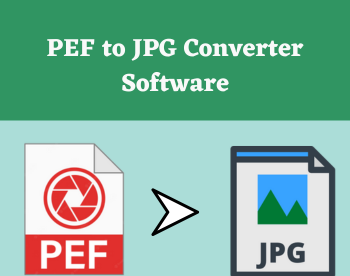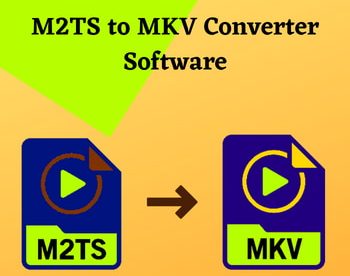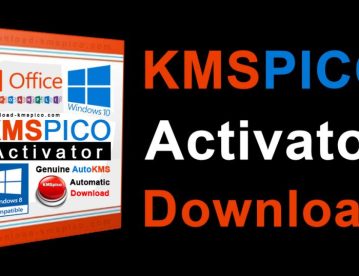7 Best Free Self Hosted Blogging Platforms For Windows
Here is a list of best free self-hosted blogging platforms for Windows. As these are self-hosted platforms thus, you can locally host them in your Windows system. Although, you need web hosting software like XAMPP to host and run these platforms. With the use of these platforms, you can create websites and also host them in your system. These platforms also offer all the necessary tools to create blog posts and publish posts to your websites. Plus, other essential administrator tools to grant different sets of permissions for users like can edit post, only view post, manage posts, etc. Most of these platforms also optimized for search engines to improve the ranking and traffic of your websites. To improve SEO, these software offers SEO compatible fields (title, subtitle, meta description, readable URLs, etc.).
For novice users, most of these platforms are not that suitable as they need knowledge of PHP, HTML, CSS, etc.. Although, some of these platforms are specially developed for novice users. These platforms also support plugins that allow you to add more features according to your requirements. Some of them can also incorporate APIs that enable you to connect your content with various web applications and websites. In general, all of these platforms are capable self-hosted blogging platforms. Go through the list to know more about these platforms.
My Favorite Self Hosted Blogging Platforms For Windows:
WordPress is my favorite platform because it offers a complete set of tools to create and manage websites and posts. Plus, it is well optimized for search engines.
Joomla is another good platform that you can try as it also offers a good set of features that you need to create and manage websites and posts.
You can also check out lists of best free WYSIWYG HTML Editor, Local WordPress Development, and Open Source Journal software for Windows.
WordPress
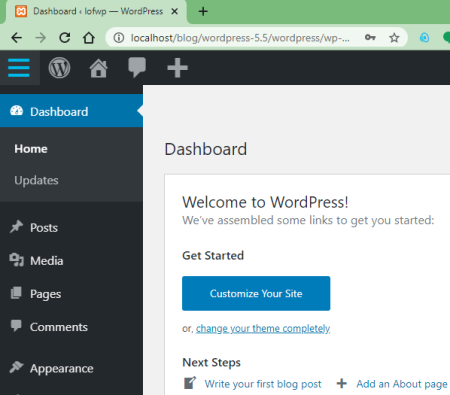
WordPress is a free open source self-hosted blogging platform for Windows and Linux. Through this software, you can locally host one or more websites. Although to create a local server and maintain a database, you need web hosting software like XAMPP.
This software offers a complete environment to write and publish articles on your websites. In it, you also get a variety of templates that you can choose for your blog. Plus, options to add multiple users are also present in it. This platform also supports plugins that enable you to add more features according to your requirements. Now, check out its main features:
Main Features:
- Flexibility: This platform gives you the flexibility to create various types of websites such as business websites, personal blogs, news websites, networks of websites, etc.
- Simple Publishing Tools: This platform offers simple publishing tools through which you can easily write blogs, manage blogs, publish blogs, create pages, create posts, schedule posts, manage revisions of posts, and more.
- User Management: The administrator of this platform can add multiple users and give each user a different set of permissions.
- Media Management: In this platform, you can easily upload images to add them to your posts. To quickly access and manage images, it offers a separate Media section.
- Plugins Support: You can find a large set of WordPress plugins on the internet that helps you introduce more features to this platform.
- Search Engine Optimized: This platform is also optimized for search engines that help your websites rank higher and gain more traffic. Plus, various SEO plugins are also available for WordPress that you can add to further improve search engine optimization.
Final Thoughts:
It is one of the best free self-hosted blogging platforms through which you can create and host your websites in your system.
Joomla
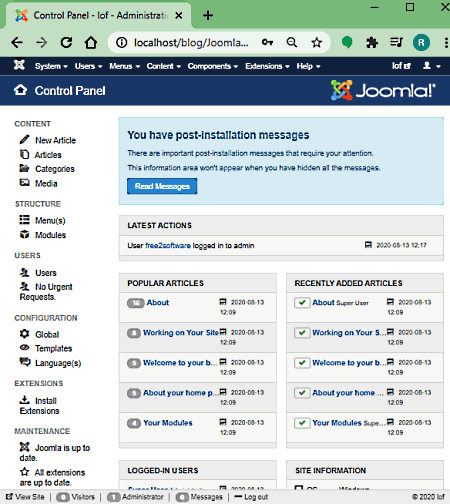
Joomla is another free open source self-hosted blogging platform for Windows. Through this platform, you can create, organize, manage, and publish blogs on different types of websites. These platforms help users to grow their websites and applications by connecting with a large Joomla user base. To locally host websites using Joomla, you need web hosting and database software like XAMPP which is also completely free. Now, check out its main features.
Main Features:
- Flexible Platform: It is a very flexible platform that allows you to create custom layouts, templates, custom CSS, and more. Plus, it offers thousands of verified templates and extensions that you can easily install on this platform.
- Search Engine Optimized: Joomla is optimized for search engines out of the box. Plus, it comes with multiple built-in SEO tools to help you optimize keywords, metadata, URLs, etc.
- User Management: It offers advanced user management features through which an administrator can divide users in various categories like author, media manager, etc. According to the category of users, they get different sets of privileges like ability to edit, ability to view, ability to just manage media, etc.
- Content Management: Using content management features, you can write new articles, publish articles, preview articles, upload images, and manage images present in articles.
Additional Features:
- This platform also offers additional tools like cache management, easy core update, user registration (to gain access to additional resources), and more.
Final Thoughts:
It is a capable self-hosted blogging platform through which you can create websites, manage websites, post content to websites, etc., without needing a third-party server.
Grav
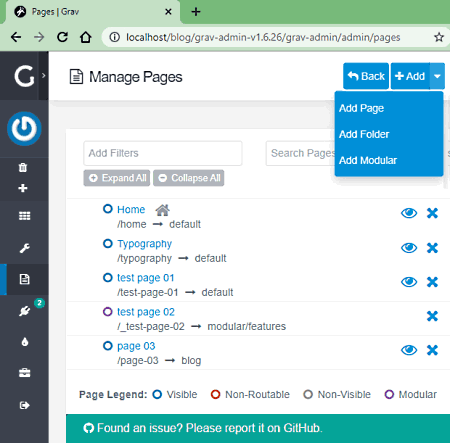
Grav is yet another free open source self-hosted blogging platform for Windows. It is a fast and extensible platform that allows new users to establish new websites without going through a steep learning curve. It also comes with a large set of plugins and themes to customize posts and websites as you want. It also needs a web-hosting software to rub. Now, check out its main features.
Main Features:
- Multi-Site Support: Through this platform, you can run and manage multiple websites and other advanced setups with ease.
- SEO Friendly: It offers useful elements like human-readable URLs across websites and per-page metadata support. Besides this, it also gives you page routing and redirection capability that helps you improve website SEO.
- Users and Roles: In this platform, an administrator can easily add multiple users and specify their roles and privileges like can access and edit articles, only read articles, etc.
- Pages: Using it, authorized users can easily create new posts, preview posts, publish posts, and manage existing posts with ease.
- Plugins: Through this section, you can add new plugins to this platform, update existing plugins, and delete plugins if you want.
Additional Feature:
- Tools: It offers multiple tools through which you can take backup of your posts, schedule backups, view logs, and more.
Final Thoughts:
It is a feature-rich self-hosted blogging platform that can be used by both novice and advanced users as it offers all the latest features without increasing complexity for its users.
Known

Known is a free open source collaborative social publishing software for Windows. You can also use it as a self-hosted blogging platform. It is mainly developed to work with shared websites so that multiple users can post blogs, images, status, etc. To run it in your Windows system, you need a web browser and a web hosting software like XAMPP. Let’s take a brief look at the main interface of this platform.
Main Features:
- Multi-Author: In this platform, you can add multiple collaborators to create and manage multi-user websites.
- Posts: Using it, you can create a new text post and post it publically or privately to a connected website.
- Status Update: Use it to update your status so that other users can also view it.
- Photo: It lets you upload photos that you can later incorporate to your posts.
- API Support: This platform also supports third-party APIs that you can incorporate to this platform to connect with various web applications.
Additional Features:
- It contains many other useful features like responsive layouts, tags support, Javascript support, CSS support, etc.
Final Thoughts:
It is simple to use self-hosted blogging platform that offers a great environment for the management of shared and multi-user websites.
Drupal
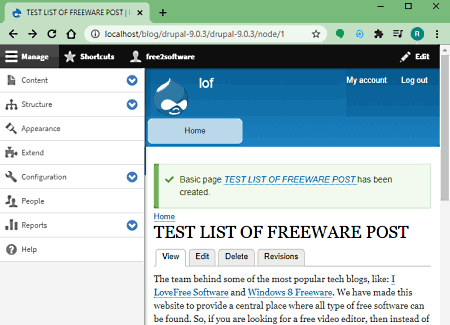
Drupal is the next free open source self-hosted blogging platform for Windows. It is primarily a web content management platform through which you can create responsive web applications and websites. In addition to that, it also offers all the tools to create and publish posts to websites. Similar to other self-hosted blogging platforms, it also needs hosting software like XAMPP and a web browser to work. Now, check out its main features.
Main Features:
- Mobile First: All the websites created with this platform are much more optimized for smartphones and tablets to deliver optimal visitor experience.
- Integrated Digital Experience: This platform integrates with business applications and digital marketing technology to offer you the best set of tools. It also supports APIs that enable you to connect content with various web applications and websites.
- Easy Content Authoring: It provides WYSIWYG editor so that novice users can also build websites and webpages with it. Plus, all the administrator permission structure, posts creation, post publishing, etc., are also present in it.
- Reports: Through this feature, you can generate log reports, status updates, top search phrases, top access denied errors, and more.
Additional Features:
- It offers many additional features such as multi-site support, tools for businesses, themes, and more.
Final Thoughts:
It is another capable self-hosted blogging platform that provides all the essential features to manage content post content, manage websites, etc.
MaxSite CMS
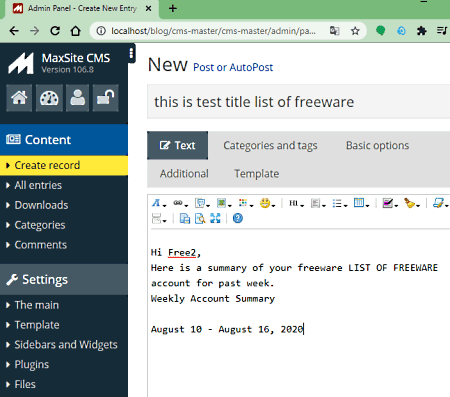
MaxSite CMS is another free open source self-hosted blogging platform for Windows. This platform is specially designed for novice users so that they can easily establish a website and post content on it. Still, all the important Administrator, Safety, and SEO optimization features are present in it. To host this platform, you need a web-hosting software such as XAMPP along with a web browser. Let’s take a brief look at the main features of this platform.
Main Features:
- Permissions: This platform offers the most comprehensive set of permissions that an administrator can give to other users such as access to categories, access to view comments, allow members to change passwords, allow to change author, admin access to edit pages, and more.
- Content: Through this section, you can create new posts with added images, edit existing posts, manage posts, and also adjust sidebar settings.
- SEO Promotion: To improve SEO, it offers SEO optimized fields and behind the scene methods such as title, description, OpenGraph, sitemap.xml, meta-fields, RSS, and more.
- Plugins Support: This platform also supports plugins that helps you introduce more features like contact forms, polls, social bookmarking, etc.
Limitation:
- The default interface of this platform is written in the Russian language, thus you need to add a language translation extension to your browser like Google Translate to convert it to the English language.
Final Thoughts:
It is another good self-hosted blogging platform that you can set up in your system to manage your websites and posts.
typecho
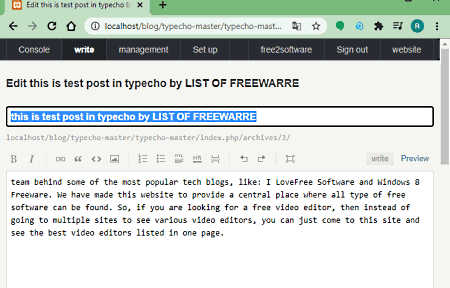
typecho is another free open source self-hosted blogging platform for Windows. It is a PHP based software that needs a web browser and web server software like XAMPP to work. It is a basic self-hosted blogging platform that comes with one template to create websites. Unlike other similar platforms, you will not find third party templates and extension for this platform. Although, you still get features to create posts, publish posts, create websites, etc. Now, check out its main features.
Main Features:
- Setup: Using it, you can connect this platform with a website by providing the website name, website URL, etc. Besides this, it also lets you make changes to comments and permalink settings.
- Write: Through this section, you can create new post and write content in it. After completing a post, you can use the Publish Page option to publish your post to your website. Before publishing your post, you can also preview it using the Preview Page option.
- Management: Using it, the admin of this platform can add multiple users and manage files, classifications, articles, comments, and independent pages.
Limitation:
- This platform comes with very basic features and lacks support for plugins and extensions.
- By default, the interface of this software contains mandarine language, thus you need to use an online translator extension to convert it to the English language.
Final Thoughts:
It is a simple self-hosted blogging platform that beginners can use to manage websites and posts.
Naveen Kushwaha
Passionate about tech and science, always look for new tech solutions that can help me and others.
About Us
We are the team behind some of the most popular tech blogs, like: I LoveFree Software and Windows 8 Freeware.
More About UsArchives
- May 2024
- April 2024
- March 2024
- February 2024
- January 2024
- December 2023
- November 2023
- October 2023
- September 2023
- August 2023
- July 2023
- June 2023
- May 2023
- April 2023
- March 2023
- February 2023
- January 2023
- December 2022
- November 2022
- October 2022
- September 2022
- August 2022
- July 2022
- June 2022
- May 2022
- April 2022
- March 2022
- February 2022
- January 2022
- December 2021
- November 2021
- October 2021
- September 2021
- August 2021
- July 2021
- June 2021
- May 2021
- April 2021
- March 2021
- February 2021
- January 2021
- December 2020
- November 2020
- October 2020
- September 2020
- August 2020
- July 2020
- June 2020
- May 2020
- April 2020
- March 2020
- February 2020
- January 2020
- December 2019
- November 2019
- October 2019
- September 2019
- August 2019
- July 2019
- June 2019
- May 2019
- April 2019
- March 2019
- February 2019
- January 2019
- December 2018
- November 2018
- October 2018
- September 2018
- August 2018
- July 2018
- June 2018
- May 2018
- April 2018
- March 2018
- February 2018
- January 2018
- December 2017
- November 2017
- October 2017
- September 2017
- August 2017
- July 2017
- June 2017
- May 2017
- April 2017
- March 2017
- February 2017
- January 2017
- December 2016
- November 2016
- October 2016
- September 2016
- August 2016
- July 2016
- June 2016
- May 2016
- April 2016
- March 2016
- February 2016
- January 2016
- December 2015
- November 2015
- October 2015
- September 2015
- August 2015
- July 2015
- June 2015
- May 2015
- April 2015
- March 2015
- February 2015
- January 2015
- December 2014
- November 2014
- October 2014
- September 2014
- August 2014
- July 2014
- June 2014
- May 2014
- April 2014
- March 2014
